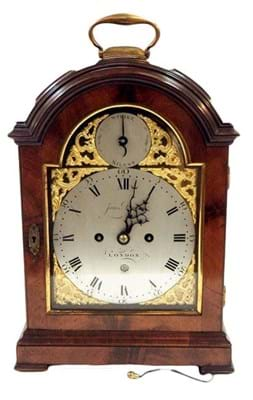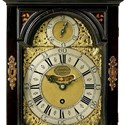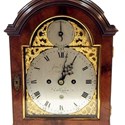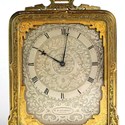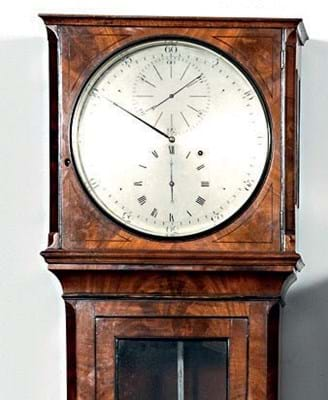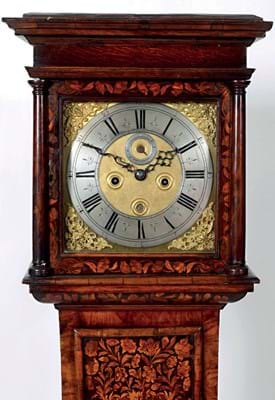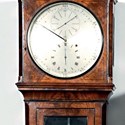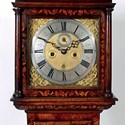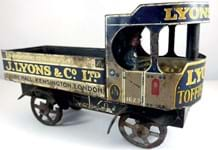Offered at Chiswick Auctions (25% buyer’s premium) on December 5, the 18in (46cm) high, ebony-veneered, quarter-repeating clock with gilt-brass mask escutcheons was signed to the 6½in (16.5cm) break-arch brass dial Quare & Horseman London.
The single fusee timepiece movement with verge escapement featured a pull cord to repeat the hours on one bell and the quarters on another. All in working order but not fully tested, it sold right on the mid-estimate, going to a UK collector at £30,000.
Respected maker
Table and bracket clocks have been the horological favourites since the bottom fell out of the general longcase market and there was an intriguing example at the Cotswold Auction Company’s (20% buyer’s premium) sale in Cheltenham on December 8.
The 17in (44cm) tall (handle-up) repeater clock was catalogued as George III but signed to the brass, broken-arch dial James Drury, London.
Warwickshire-born Drury was free of his London apprenticeship in 1697 and was a respected maker before his death in 1741, making this probably a George II piece. It had an eight-day verge movement striking on the hours and was sold with a matching wall-mounting cushion-shaped bracket.
That its owners appreciated it was evident from the inclusion of a professional cleaner’s bill dated 1892.
Bidders at Cheltenham liked it just as much. It doubled the top estimate, selling at £3600.
Cole struts his stuff
The gilt-brass timepieces designed by Thomas Cole (1800-64) are highly collectable today – as seen when an example came up at Halls (20% buyer’s premium) at Shrewsbury on December 12.
The son of a Somerset clockmaker, Cole moved to London in his 20s, established his own business c.1838 and by 1845 was doing well enough as a ‘designer and maker of ornamental clocks’ to be selling through the fashionable Mayfair retailer CH Hancock.
At the 1851 Great Exhibition he launched his new designs of 30-hour flat ‘strut’ clocks, some rectangular, others oval-shaped, such as the 5½in(14cm) high example offered in Shrewsbury.
Numbered 1041 (Cole numbered all his post-1846 clocks from 500 to 1900), the clock’s back plate with folding winding handle and escapement shutter was engraved CF Hancock by appointment to the principal sovereigns & Courts of Europe, 39 Bruton Street, London.
Pitched at £1500-2000, it sold at £3700.
Active longcases market
Now that vendors have accepted the realities of lower prices, the market in longcases is at least active and items with something extra or some rarity, such as a c.1840 regulator offered in a Market Harborough sale, can still exceed measured expectations.
The example featured in Gildings’ 15% buyer’s premium) auction on December 4 included an austere 6ft 4in (1.94m) mahogany case enclosing a movement with mercury compensating pendulum.
The silvered dial was signed Widenham London, probably for City maker Richard Widenham of Red Lion Square and later Lombard Street. Estimated at £2000-3000, it sold to a UK specialist dealer at £5500.
A longcase offered at Charterhouse (22% buyer’s premium) in Sherborne, Dorset, on December 14 was a more decorative piece: undated in the catalogue but at its core was a late-17th century five-pillar eight-day movement and a 6ft 8in (1.98m) case walnut marquetry veneered case. The movement and dial bore no visible marks as to maker.
It was illustrated on the catalogue cover and estimated at £3000-4000 – a guide more than justified when it sold at £4200.



